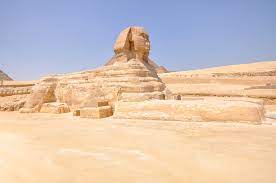
Youtube
The Sphinx is a huge, monolithic statue at the foot of the Pyramids at Giza in Egypt. Its body shape is like that of a lion while its head is that of a human being. The statue’s age is not known, only speculated. It’s the greatest mystery about the structure.
Its scars show its antiquity. The statue is heavily eroded and damaged but has yet stood from time immemorial. Its origins are a mystery even more than the Pyramids which it stands next to. The Great Sphinx of Giza is one of the best-known statues on the surface of the earth.
However, despite being analyzed by numerous studies and research analyses, the age of the Sphinx, the era in which it was created, and who it was created for is still unknown. Even its real name is unknown as there are no writings in Egypt that make a mention of the statue.
The statue stands near a pyramid that has been attributed to the Pharaoh Khafre. It’s considered the oldest sculpture in Egypt. It measures 73 m (240 feet) from the paw to the tail, 20 m (66 feet) high from the base to the top of its head, and 19 m (62 feet) wide at its rear haunches. The Sphinx is thought to have been built by Pharaoh Khafre, who was the builder of the second-largest pyramid at the plateau of Giza.
It is thought to be among the oldest and largest statues in the world and is the subject of several legends and myths. Hence it is not surprising that many scholars and researchers state that the Sphinx is far older than 4500 years, which is the age attributed to it by Egyptologists. This would mean that the Sphinx may have been created at a time when there were no advanced civilizations on the surface of the planet.
Though scholars and experts have refuted the possibility of such a civilization having existed, it is known that around 11,000-13,000 years prior that the Earth was peopled by a culture that was capable of extracting stones weighing many tons from quarries and constructing temples and structures which were aligned with the stars in the heavens based on astronomic principles.
The analysis of erosion patterns from the statue has shown that the Sphinx may have not been carved during the Fourth Dynasty of Egypt but rather much earlier between 15,000 to 5,000 BC. Though not mentioned in any ancient texts, studies of the statue and its position aligned with the stars have revealed that these aspects may contain interesting facts about the Sphinx. The Sphinx, like the other pyramids which stand next to it in Giza, is considered to be very astronomically constructed.
Some scientists have claimed that the Sphinx and its position at the Giza plateau are situated in precise alignment to the Leo constellation in the skies and date it back to 10,500 BC. However, whether the statue was indeed built at that time or not is a matter of speculation and conjecture as there is no firm evidence regarding it. Experts however agree that the Sphinx is the most impressive work of sculpture in human history.
According to Egyptologist Miroslav Verner, the Sphinx is more than being symbolic of Egypt as it is the very personification of antiquity and mystery. It has inspired people including poets, scientists, travelers, and adventurers over time. Although it has been examined and analyzed using the most modern and cutting-edge techniques, the basic questions about it remain unanswered viz. who built it, when was it built and why was it built? Another expert Selim Hassan stated in 1949 that the statue can be attributed to the Pharaoh Khafre but with the reservation that it is based on circumstantial evidence until the time when some credible evidence can be found which will definitely prove the age of the Sphinx. However, there is no proof linking the Sphinx to an exclusive timeline in human history until now.
Even though many scholars consider the Sphinx to date from the Fourth Dynasty of Egypt, others were convinced that it was not so. One example was Egyptologist E. A. Wallis Budge who was convinced that the Sphinx was older than the Fourth Dynasty of Egypt. In his book ‘Gods of the Egyptians’ (1914), Budge mentioned that the Sphinx was existent in the time of the Pharaohs Khafre or Khephren and that it could have probably dated from the end of the archaic period in circa 2686 BC. Other Egyptologists like Gaston Maspero believed that the Sphinx was possibly the oldest statue in ancient Egypt.
Many scholars also believe that it was Pharaoh Khafre who created the statue and that its head is a representation of him. But forensic experts like Frank Domingo from the New York City Police Department believe based on forensic research that this is not so. The Sphinx was considered ancient by the time of Pharaoh Ramses and King Tutankhamen and it was first restored around 3500 years ago.
Though its exact age is unknown, without having access to a time machine even the most prominent Egyptologists cannot say that the Sphinx has been built in the image of the Pharaoh Khafre as stated in the book, ‘The Message of the Sphinx’.